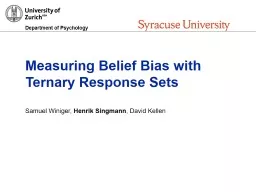

Samuel Winiger Henrik Singmann David Kellen Syllogism Logical arguments Premise Premise Putative Conclusion No oaks are jubs Some trees are jubs Therefore some trees are not oaks ID: 795962
Download The PPT/PDF document "Measuring Belief Bias with Ternary Respo..." is the property of its rightful owner. Permission is granted to download and print the materials on this web site for personal, non-commercial use only, and to display it on your personal computer provided you do not modify the materials and that you retain all copyright notices contained in the materials. By downloading content from our website, you accept the terms of this agreement.
Slide1
Measuring Belief Bias with Ternary Response Sets
Samuel Winiger, Henrik Singmann, David Kellen
Slide2Syllogism
Logical arguments:Premise:Premise:Putative Conclusion
No oaks are
jubs
.
Some trees are jubs.Therefore, some trees are not oaks.
Valid
Inv
alid
Slide3Belief Bias in Syllogistic Reasoning
Believability
Validity
Believable
Unbelievable
Valid
No oaks are jubs.No trees are jubs.
Some trees are
jubs
.Some oaks are jubs.Therefore, some trees are not oaks.Therefore, some oaks are not trees.InvalidNo trees are jubs.No oaks are jubs.Some oaks are jubs.Some trees are jubs.Therefore, some trees are not oaks.Therefore, some oaks are not trees.
Slide4Belief Bias in Syllogistic Reasoning
Believability
Validity
Believable
Unbelievable
Valid
No oaks are jubs.No trees are jubs.
Some trees are
jubs
.Some oaks are jubs.Therefore, some trees are not oaks.Therefore, some oaks are not trees.InvalidNo trees are jubs.No oaks are jubs.Some oaks are jubs.Some trees are jubs.Therefore, some trees are not oaks.Therefore, some oaks are not trees.
89
%
71%
56%
10%
Data: Evans et al. (1983)
Slide5Belief Bias in Syllogistic Reasoning
Believability
Validity
Believable
Unbelievable
Valid
No oaks are jubs.No trees are jubs.
Some trees are
jubs
.Some oaks are jubs.Therefore, some trees are not oaks.Therefore, some oaks are not trees.InvalidNo trees are jubs.No oaks are jubs.Some oaks are jubs.Some trees are jubs.Therefore, some trees are not oaks.Therefore, some oaks are not trees.
89
%
71%
56%
10%
Data: Evans et al. (1983)
Two possible explanations:
Believability affects reasoning processes
(e.g.,
more effort for unbelievable syllogisms)
Believability
affects response bias
(e.g., higher propensity for accepting believable
conclusions)
Slide6Threshold-Model for Belief Bias
Klauer,
Musch
&
Naumer
, (2000)
Slide7Threshold-Model for Belief Bias
Klauer,
Musch
&
Naumer
, (2000)
Problem:
Data provides 4 independent data points
Model has 6 free parameters
(4 reasoning and 2 guessing parameters)Model parameters not uniquely identifiedKlauer et al.'s solution: response bias manipulationParticipants in one of three bias condition:17% versus 50% versus 83% validFix reasoning parameters across conditions, but allow for different response biasBelief bias solely affected reasoning processes.
Slide8Signal Detection Model of Belief Bias
Dube,
Rotello
, &
Heit
(2010)
Slide9Signal Detection Model of Belief Bias
Dube,
Rotello
, &
Heit
(2010)
Signal detection based analysis with confidence-rating:Belief bias mainly a response bias effect!(also Trippas, Kellen, Singmann, et al. in press, PB&R)
Slide10Experiment
Syllogism evaluation task with 3 response options:"valid""I don't know""invalid"
Belief Bias: Driven by reasoning processes or response processes?
Logical validity (valid vs. invalid)
Conclusion believability (believable vs. unbelievable)
354 Participants (online study) 8 syllogisms per participant7/26/2018Title of the presentation, AuthorPage 10
Slide11Results: Response Frequencies
7/26/2018Title of the presentation, Author
Page
11
Slide12r
vu
1-
r
vu
n
u
1-
n
ugu1-guI don’t knowvalidvalidinvalid
valid and unbelievable
r
vb
1-
r
vb
n
b
1-
n
b
g
b
1-
g
b
I don’t know
valid
valid
invalid
valid and believable
r
ib
1-
r
ib
n
b
1-
n
b
g
b
1-
g
b
I don’t know
invalid
valid
invalid
invalid and believable
r
iu
1-
r
iu
n
u
1-
n
u
g
u
1-
g
u
I don’t know
invalid
valid
invalid
invalid and unbelievable
Extended Threshold Model
Slide13Modeling Results: Extended belief bias MPT
7/26/2018Title of the presentation, Author
Page
13
Slide14Modeling Results: Extended belief bias MPT
7/26/2018Title of the presentation, Author
Page
14
BF
0: 1.4 – 2.0
BF0: 0.8 – 1.6
BF
0
: 2.1 – 4.5 BFAlt: 16 – 230
Slide15Summary
Binary "Valid"/"Invalid" response format does not provide independent data points for comprehensive measurement model of belief bias
Klauer et al. (2000): threshold model
Response bias manipulation
Believability affects reasoning processes
Dube et al. (2010); Trippas et al. (in press); Stephens, Dunn, & Hayes (2017): signal-detection modelConfidence-ratingsBelievability affects response processesOur results: extended threshold modelTernary response setsBelievability affects response processes (i.e., larger propensity for responding "valid" for believable syllogisms)Differences in conclusions not dependent on model, but manipulation for achieving parameter identifiability.Substantive theories of belief bias must include response bias!7/26/2018Title of the presentation, Author
Page 15
Slide167/26/2018
Title of the presentation, AuthorPage
16
Thank you for your attention.
Questions?
Slide17Syllogisms
Structures
Complex
structures (indeterminately invalid)
-
Dube et al. (2010) experiments 1-3- Klauer et al. (2000) experiments 3, 4, and 7.This set includes Trippas et al. (2013) and Stephens et al. (2017)
ContentsRated contents from all around the literatureKlauer et al., 2000
Dube
et al., 2010
Ball, Phillips, Wade, & Quayle, 2006Oakhill & Johnson-Laird, 1985Quayle & Ball, 2000; Evans et al., 19837/26/2018Title of the presentation, AuthorPage 17
Slide18Results: Bayes Factors
Bayes factors derived from the difference parameters between conditions* Bayes factors in favor of the null Hypothesis
7/26/2018
Title of the presentation, Author
Page
18Parameterrvrin
gnarrow prior1.4*1.22.1*232.0medium prior1.5*1.3*3.1*
70.3
wide
prior2.0*1.6*4.5*16.1